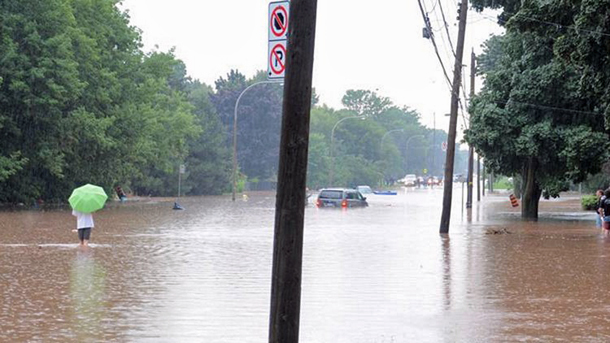Last summer, the people of Burlington, on the western edge of Lake Ontario, found themselves the target of a rogue weather system that dropped 7.5 inches of rain on their city in less than three hours. People had to swim from their abandoned cars. More than 3,000 homeowners suffered property damage, including Burlington's mayor, Rick Goldring, whose basement accumulated a full five feet of water.
"I have never seen flooding like I saw on Aug. 4, 2014," Goldring says. "It was very disconcerting, very discombobulating."
But it wasn't only water rising in Burlington. The price of home insurance is being pushed higher by climate change as well and that means for many Canadians and Ontario and beyond, climate change is getting as personal as their bank account bottom lines.
A big wet elephant
Environment Canada's senior climatologist called the 2014 downpour one of a "new breed" of storm that, rather than sweep across a region as summer thunderstorms tended to do, instead targeted very small areas with a huge amount of precipitation. Although Ontario has always been prone to flooding, this past decade has seen more significant storms, causing flash floods of the scale seen in Burlington that have overwhelmed municipal storm and sewage systems.
Hundred-year storms are now happening more like every 10 years, and experts say we can no longer count on storm water and sewage systems to reliably keep water out of our streets, backyards and basements. The damage wreaked in these storms is costing municipalities, taxpayers and homeowners a lot of money, and experts closely watching the flood phenomenon across the country say if we want to stay out of debt, we need to plan for the worst.
Blair Feltmate, an associate professor in the University of Waterloo's School of Environment, Enterprise and Development calls flooding "the big elephant in the room in this country."
Feltmate has spent much of his career studying how extreme weather events caused by climate change, particularly floods, are impacting communities. "The bottom line for homeowners?" he says. "Insurance premiums are going up."
Indeed, insurance companies are already seeking ways to limit their costs associated with climate change, says Craig Stewart, vice-president of federal affairs for the Insurance Bureau of Canada.
"The property and casualty insurance industry has been on the front lines of this," Stewart recently told CBC News. "For the industry, climate change is a priority. We're working with every level of government to try to impress preparedness."
The Burlington storm was just one of several that the Insurance Bureau of Canada deems "catastrophic," in excess of $25 million in insurable damages. Peterborough in July 2004 got nine inches of rain in a 24-hour period (resulting in 8,000 flooded properties and $100 million in insurance claims). In the summer of 2013, the Greater Toronto Area received five inches of water in a day (as much as the city would normally receive in the entire month, and then some). Five thousand residential basements were flooded and the Insurance Bureau of Canada reported that insured property damage was estimated to be in excess of $850 million, and costs to the city itself were $170 million, making it the province's costliest natural disaster.
But according to Carolyn Rennie, the director of Catastrophic Loss Analysis at Catastrophe Indices and Quantification Inc., a company that collects data for the bureau, since 2008 there have been 14 flood events in Ontario that cost insurers less than $25 million but more than $10 million -- still significant events.
From 1983 to 2007, Canadian insurers paid out on average $200 to $500 million per year in home insurance claims. From 2009 onwards, insurers paid out on average more than $1 billion a year in home insurance claims. Claims in 2013 alone (largely due to the Toronto flood, and the devastating Bow River flood in Calgary) totalled $2.3 billion. For the past nine years, says Feltmate, the insurance industry has paid out more in home insurance claims that it has collected in premiums and deductibles. And it's passing those costs on to consumers. Customers with Intact saw their rates increase by 15 to 20 per cent last year, and the chief underwriter for TD Insurance announced that its customers could expect a 10 to 15 per cent spike in rates).
Burlington Mayor Goldring says one of the biggest things the great flood of 2014 taught him is the inconsistencies in the insurance coverage -- specifically the lack of overland flood (coverage for groundwater that seeps in through the windows or foundation) insurance in Canada, which is unavailable from most major insurers. Most standard home policies only cover sewage backups and burst pipes. The difference between clear fresh water coming in through the window and murky sewer water coming in through the pipes can make all the difference.
Although Goldring says most residents were covered by insurers, there were still those who were not, or were not totally covered. In addition to the insurance money, Burlington residents raised nearly $1 million in aid, which was matched by the province's disaster relief fund to help those who weren't.
Feltmate says he sees it all the time, as a guest on radio call-in shows. "Someone's been paying insurance on the same home for 20 years, never made a claim, all of a sudden there's three feet of water in the basement, and the adjustor comes and points out the water stains coming down the wall and won't cover it," he says. "People go apoplectic."
The new climate insurance
Major insurance companies are beginning to address these gaps.
In 2010, the Institute for Catastrophic Loss Reduction (which is affiliated with Western University,* and whose membership includes more than two dozen insurance companies from around the country), released a report called "Making Flood Insurable for Canadian Homeowners" that looked at the very issue of how to better cover flood events.
It pointed to the United Kingdom as a model that Canada could adopt. There, home insurance is bundled; in other words, it's a package deal that covers flood, wind, fire and other disasters. Although pricing is based on risk -- if you live in a flood prone areas, you're going to pay more -- the base cost is spread out amongst everyone. Although it's an entirely private insurable sector, the federal government bears the responsibility of keeping flood risk maps complete and current -- which allows insurance companies to better assess risk, and sets a higher price on developing in areas that are prone to or will be prone to flooding.
What this will require is major cooperation at a provincial and federal level. The last major exercise in flood risk mapping started in 1975, with the federal Flood Damage Reduction Program. The program split the cost of flood mapping between the provinces and the federal government. Hundreds of municipalities across the country were mapped for flood risk areas, and civil servants report it was effective in steering development away from those areas. Despite this, the program was phased out in the early 2000s -- and as a result, Canada's flood risk maps are woefully out of date.
Time to weather audit your home?
In the meantime, Feltmate is working on several solutions that wouldn't necessarily require buy-in from municipalities but could work directly with property owners. One is a cost-benefit analysis of compensating landowners to leave wetlands on their property intact (95 per cent of wetlands in Ontario are on private property). This kind of research has already been done other countries, like Australia, for example, and all the studies come back with rates of return that are "off the charts," says Feltmate. "The rule of thumb seems to be for every dollar spent, there's a six-to-twelve-dollar return on investment."
Feltmate is also expanding a pilot home adaptation program, similar to a home energy audit, that focus on small, low-cost actions that homeowners can do to lower the probably of basement flooding by anywhere from 20 to 80 per cent. It's been run in about 400 homes in the Kitchener Waterloo area over the past six years, and found that within six to eight weeks of an audit, 75 per cent of homeowners have implemented changes.
They've been doing pilots for six years now, and they have verified that when there is a big storm in the areas, houses that have been audited and successfully retrofitted are less likely to be flooded. "It costs about $275 to do the audit, and if you can save that $20,500 of the average cost of a flooded basement, it's big savings." (See sidebar for more on what homeowners can do.)
Who might pay for such a program? That's the million-dollar question, says Feltmate. All of these types of measures, he believes, need to be approached in a coordinated way by federal, provincial and municipal governments.
"What resonates with homeowners, with voters?" asks Feltmate. "Not having a flooded basement."
*Story corrected Nov. 24 at 10 a.m. ![]()
Read more: Housing, Environment

















Tyee Commenting Guidelines
Comments that violate guidelines risk being deleted, and violations may result in a temporary or permanent user ban. Maintain the spirit of good conversation to stay in the discussion.
*Please note The Tyee is not a forum for spreading misinformation about COVID-19, denying its existence or minimizing its risk to public health.
Do:
Do not: